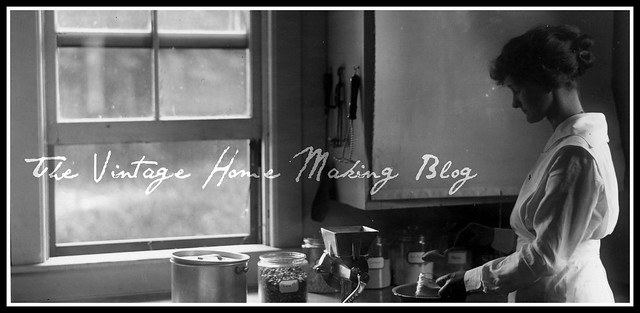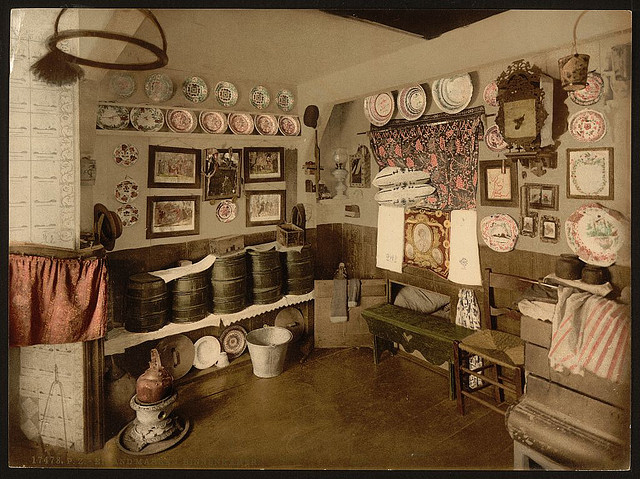There are two stages to a spring clean for us - The first one is editing my home and the second one involves scrubbing it. We have edited regularly for the last three or four years because we have moved on average once or twice a year. This is the first time we've gone into our second year in the same house since I left college so this year I've had to be very deliberate about making sure that I go through a process of really thoroughly editing every nook and cranny, drawer, or hidden cabinet.
The reason that I edit, or de-clutter, my things before I do a large scrub is that it is simply easier to clean once my house is de-cluttered. There are fewer things to move around, I've already done some surface cleaning like dusting and sweeping, and I don't have to reorganize as I'm trying to scrub. Organization requires a bit of thought - not too much - but it does help to keep your mind on the practical side of things.
For example, my husband and I kept our board games up on the highest shelf of the built ins. We have amazing board games that deserve to be played but rarely were because they were out of sight and almost always out of mind. When I reorganized the built ins I placed them on a lower shelf and put the fabric stash up where they were since I don't usually use stash fabrics for projects. Since then we've been playing our games more after dinner which is a great way to have together time and be a little competitive.
So far, we've been at it three days, going room by room starting at the back of the house (which is the oposite direction I do my 15 minute nightly tidy-ups in) because I know the bedroom and built ins are the places I stash the most clutter and get the least amount of tidying on a regular basis.
Here are few things to help you get ready for spring clean or any sort of big scrub of your house as well.
1. Have a visual goal: Every year when I edit my house I have an idea of how I want my house to look - calm, collected, elegant, vintage, a little modern, airy, and light. I keep a board on pinterest and when it comes time to stage my home or de-clutter/redecorate I can look and see what running themes I have on my board. For example, I noticed that a lot of my pictures have big white rooms (check) with high ceilings (check) and a mix of modern Scandinavian (not so check) and antique (check) furniture. Because I have a clear picture of what I like I can edit out the things I don't like or don't work and arrange my home in such a way that these things are featured. I see what is missing, needs to be updated, and I write it down to make or purchase at a later date.
2. Start at one end of the house, do one small space at a time: Editing can be intimidating because you have to make decision after decision about things. I try to keep the overwhelming sense of "I have so much stuff" that hits me when I'm going through closets and storage bins down to a minimum by doing a little at a time. I started by writing down my rooms in order that I want to tackle them. My house is a pre-war 5 room with a front and back hall. It made sense to move in a direction. If your house is larger or you have some rooms that are used more often than others perhaps you'd like to do this in the order of how often they are used or how much is in them getting the rooms with the least amount of clutter done and out of the way first. After I decide the order of rooms I compartmentalize (I generally do this in my head) it into sections. My bedroom is the most overwhelming room to declutter so I broke it down into closet/nightstand/bookcase/under bed/dresser and just tackled each at a time. If you tear apart the whole room you may end up running out of steam with everything in your closet and dressers on your floor and no energy to put it back!
3. If you don't use it or love it toss it: I believe every organizational guru from Martha to Marla has said this at one point or another but it holds true. Lose the guilt associated with tossing something you paid good money for or the guilt associated with getting rid of a gift and free up a little space in your life. This is one of those things that gets easier with experience. I used to hem and haw about tossing things but now I just go for it and don't worry about it.
4. Pull out your best things and start using them: One of my favorite ways to cut down on the clutter is to start using my good things and get rid of the seconds. I want to honor my home and family with the good china, cloth napkins, the best dishes, the good linnens, and so on. I don't want to save them because then they are simply clutter pulled out once or twice a year. Even though I still have two sets of dishes (a "good" set and the "regular set") we eat just as many meals on the good set as we do on the regular set and neither set is clutter. Instead of having stacks of paper napkins I use the cloth napkins I have collected over the years. I wear any and all of my wearable clothes whenever or wherever instead of saving them for special occasions.
5: Don't bring clutter into the house: This is a hard one for me but I am getting better. I don't bring anything into the house unless I've really thought about where or how I will work it in to my house, wardrobe, or clothing collection and whether or not I think it is truly beautiful or not. I want even the most practical thing in my home to be worthy of a beautiful home. I buy the best quality I can afford, take good care of it, and expect it to last.
Note: This post has also been posted on my other blog here.


